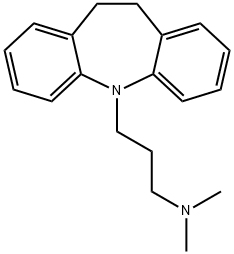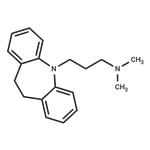Tofranil,Ciba Geigy,France,1959
Imipramine is used in depression of various etiology accompanied by motor
clumsiness and enuresis in children and Parkinson’s disease.
ChEBI: Imipramine is a dibenzoazepine that is 5H-dibenzo[b,f]azepine substituted by a 3-(dimethylamino)propyl group at the nitrogen atom. It has a role as an adrenergic uptake inhibitor, an EC 3.4.21.26 (prolyl oligopeptidase) inhibitor and an antidepressant. It derives from a hydride of a 5H-dibenzo[b,f]azepine.
20 parts of imino dibenzyl are dissolved in 100 parts by volume of absolutely
dry benzene. A suspension of 4 parts NaNH2 in 50 parts by volume of
absolute benzene are then added dropwise at 50° to 60°C after which the
mixture is boiled for an hour under reflux. 13 parts of 3-dimethylamino n_x0002_propyl chloride are then added dropwise at 40° to 50°C and the mixture is
boiled for 10 hours under reflux. After cooling, the benzene solution is
thoroughly washed with water, whereupon the basic constituents are extracted
with dilute hydrochloric acid.
The hydrochloric extract is then made alkaline and the separated base is
extracted with ether. After drying, the solvent is evaporated and the residue is
distilled in the high vacuum, whereby the N-(3-dimethylaminopropyl)-imino
dibenzyl passes over at a temperature of 160°C under 0.1 mm pressure. The
chlorohydrate with a melting point of 174° to 175°C is obtained therefrom
with alcoholic hydrochloric acid.
Janimine (Abbott);
Pramine (Alra); Presamine (Sanofi Aventis); Tofranil
(Novartis); Tofranil (Tyco).
Besides being used in the clinical treatment of depression, imipramine also has been used for the treatment
of functional enuresis in children who are at least 6 years of age (25 mg daily administered 1 hour before
bedtime, not to exceed 2.5 mg/kg daily).
Imipramine is a 10,11-dihydrodibenzazepine tertiary amine TCA that is marketed as hydrochloride
and pamoate salts, both of which are administered orally. Although the hydrochloride salt may be
administered in divided daily doses, imipramine's long duration of action suggests that the entire oral daily
dose may be administered at one time.On the other hand, imipramine pamoate usually is administered as a
single daily oral dose.
Imipramine, 5-[3-(dimethylamino)propyl]-10,11-dihydro-5H-dibenz[b,f]
azepine (7.1.1), is synthesized by the alkylation of 10,11-dihydro-5H-dibenz[b,f]azepine
using 3-dimethylaminopropylchloride in the presence of sodium amide [1¨C3].




![3-(5,6-dihydrobenzo[b][1]benzazepin-11-yl)-N,N-dimethylpropan-1-amine pictures](/ProductImageEN/2022-04/Small/bfb810d8-0788-4b71-be5a-56a4100e8fcf.jpg)
![3-(5,6-dihydrobenzo[b][1]benzazepin-11-yl)-N,N-dimethylpropan-1-amine pictures](/ProductImageEN/2021-12/Small/0bc09066-dd56-43f1-bfb7-038394de30bb.jpg)